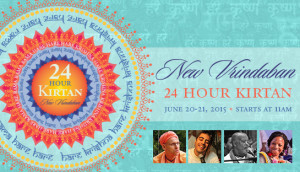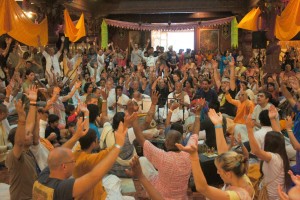Why Worry About It?
First I have to want to improve my japa. That won’t happen until (a) I’m sincere, and (b) I realize that chanting japa is more important than anything else (more important than how many times or ways I get high, have sex, consume onions, eggs and slaughterhouse milk, wear karmī clothes, don’t put on tilak, associate with so and so, and so on). This post isn’t going to go into that. Let’s just assume I already realize that the most important part of bhakti-sādhana is the Hare Krishna mantra, and I sincerely want to improve my relationship to that mantra, by chanting better japa.
Set Achievable Goals
If I can’t improve all my japa immediately, I have to at least improve some of it. I’ve found some measure of success by starting with the idea of making 25% of my japa more “first-class” – and year by year adding another 25% to that, so that after four years, all of my japa has improved. So, if you chant 64 rounds, start by making sure that at least 16 of them are pakka and really concentrated. If you chant 4 rounds, start by chanting at least 1 of them to the very best of your ability. And next year make it 50%, third year 75% and by the fourth year go for 100%.
Also, I “pace myself” to allow a sort of rhythm to my practice. I don’t try to go 1,000% all day everyday, because I’ve tried that before, wasn’t ready for it, and burned out. I let my japa be sloppier on weekends, for example, and try to increase my efforts on other days, like ekādaśī, and during kartika.
In a similar vein, I don’t try to make my day 24 hours straight perfect “Krishna consciousness.” I just want my japa time to be straight-perfect 100% effort, and let the rest of the day be whatever the heck it winds up being. Gradually, that winds up naturally becoming more and more “Krishna conscious,” anyway.
The Essence of It
The essence of good japa is nothing short of ātmanivedana – completely giving myself to Krishna. “Self” ultimately means “consciousness” (jīva is jñāna-mātra – consciousness itself). Consciousness means perception. Perception means attention. Whatever I pay attention to is whatever I give myself to. I can give myself to Krishna by paying attention to him, and I can start paying actual attention to him by giving my perceptions to his name.
The Physics of It
First rule of japa-club: don’t move around.
On the grossest level this means don’t do other things at the same time. I don’t want to chant in the car, or on a walk, or while I’m cooking or reading a book or listening to music. (Just don’t do it! Do you want to chant amazing, spiritual japa or not!? Don’t justify lame japa with a million quotes or references to saints who sometimes chanted while walking or whatever. As I mentioned, we should have a core set of japa that is first-class, but should chant even more than that, whenever and however. Anytime anyway we can.)
On a subtler level, “don’t move around” literally means “don’t move around.” As in “sit properly.” According to tradition, “sit properly” means sukham-sthiram-āsanaḥ (Sit comfortably and fixed, firm). Figuring out how to sit without discomfort (sukham) but alertly and without laziness (sthiram) takes a long time (I still haven’t figured it out entirely), but is worth the effort.
Substitute Japa
The reason we have to sit still is that we will try to chant japa without really chanting japa. We will try to be able to say or think we chanted our daily japa, without actually doing it. Why are we like this? Because we love lots of other stuff, and want to pay attention to all of that. We don’t want to pay attention to Krishna. This is natural, since we haven’t experienced him yet. But the only way we will ever experience him is to pay attention to the japa of his name, wholeheartedly, at least for a little while. So, we have to make the effort. After making an intelligent effort for some time (even jut a few week), we will start to get a bit of natural, real interest in Krishna’s name, and as we continue with this effort, that interest will grow till soon (ideally as soon as three years, I’d say) its no effort at all to chant most of our rounds attentively.
“Substitute japa” is the effort to get through my japa while paying attention to other things, thinking about other things, planning other things, dreaming about and dramatizing other things, etc. The only way this is possible is if the chanting can go on “auto-pilot.”
Rocking back and forth, shaking and twisting the beads rhythmically, and other sorts of “metronome” tempo-keepers… these are all servants of auto-pilot-japa. We move our fingers to the next bead every time we’ve twisted the bead enough, or shaken it enough, or rocked to and fro enough. We’re not counting mantras, we’re counting fidgets. Don’t do it!
Speed!
Whatever I’m doing… If I pay attention, I get it done efficiently. If I don’t pay attention, it takes forever. Therefore, the amount of time it takes me to finish japa can be somehow parallel as an indicator of how much attention I’m paying.
So I almost always try to chant as fast as I can.
It’s tiring! It’s hard! …good! That’s the idea! I chant so fast that I have to concentrate on not skipping any words. [There have to be 16 words in every mantra, and each word has to have 2 syllables every time. In “Rāma” the second syllable can often be very light, but don’t skip it.]
Very distracted mālā (rounds) take me about 10 minutes each (like if I’m literally being interrupted and stuff). Moderately distracted rounds take about 7 or 8 minutes (I’m just drifting off and thinking about everything else). Decent rounds take less than 6 minutes. Good rounds take less than 5 each. Ideal rounds are close to 4 minutes, for me. I know that some excellent chanters, such as Aindra Prabhu, aimed for 3.5 minute rounds.
Volume?
Besides speed there is volume. (And they are related, the louder the chanting the lower it’s top speed).
Śrī Rūpa says, “sulaghu” is the basic character of japa. That means “very lightly enunciate the mantra.” Don’t try to wake the dead. Chant very lightly, aiming to bring the sound to the inner ear. We should aim for increasing “lightness” in the enunciation volume.
Hari bhakti vilāsa identifies three valid approaches to japa (1) audible, (2) mouthed, (3) mental; saying that each one is more powerful than the one before it, if we do it right.
In saṁkīrtan, the louder the better. In japa the opposite is true. Audible japa is the least powerful because it is most prone to “autopiloting.” We move our fingers to the next bead every time our jaws flap around a certain number of times, or every time we make a certain noise after a certain amount of other noisy buzzing. The real point of Japa is not to make noise, but to surrender my very self (consciousness/attention) to Krishna.
[Yet, for some people audible may be the best, because its better to do autopiloted audible chanting than to do autopiloted inaudible chanting. I’ll talk more about that, below. Basically, if and when we just can’t get beyond auto-pilot chanting, then audible is better than mouthed and better still than so-called mental chanting.]
From audible to mouthed to mental, the japa does not actually lose volume. It loses external volume and increases internal volume. The mantra moves from being heard by the external ears, to being heard by the internal ear.
Everyone has and uses an internal ear all the time. Imagine some sound, you are using your internal ear. When you dream you also often solely use your internal ear. Whenever you hear, actually, your external ear is merely feeding data to the internal ear, which is the actual sense of hearing itself.
The second type of japa (“mouthed”) is the transition from external to internal hearing. Mouthing is still prone to autopilot because you can still just rely on your jaw movements to let you know you’ve “finished” a mantra. When mouthed japa autopilots its even more of a failure than when audible chanting does. That’s why we shouldn’t abandon audible chanting until we start to hear the sound in the inner ear, with concentration, at the same time as we hear it with the outer ear.
The third type of japa is mental chanting. The reason its the best is that auto-pilot is impossible. if I stop concentrating, the japa stops. Its impossible to chant inattentive mental japa, because the rounds just won’t get finished. But it’s essential that if we do mental chanting we absolutely must not do any sort of moving around, rocking, swaying, bead moving, etc. Nothing to “keep tempo.” Keeping tempo is the thing that autopilot exploits. Beware of prematurely switching to mental rounds because when we “lace” them with rocking and swaying and fall into autopilot, that japa is almost entirely useless. With audible chanting, even on autopilot at least there’s some sound drifting in our ears occasionally catching our interest. With mental chanting, when we go to autopilot, what’s left? Basically nothing except wasted time.
Closing Points
a) Deliberate breathing is an exception to the tempo-keeping rule. When I co-ordinate my breathing with the japa, it becomes very difficult to go on autopilot. This seems contradictory, but the regular flow of prāṇa keeps the mental machinery disciplined. Irregular flow of prāṇa (uncontrolled breathing) lets the mental machinery operate irregularly (go all over the place).
b) Chanting is not about mental focus. The mind actually just needs to shut the hell up and stay out of the way. The mind and the senses do not produce the Hare Krishna mahāmantra. The mahāmantra exists in a transcendent realm within the consciousness itself. Don’t think about trying to “focus the mind” on the mantra, just tell the mind to take five and rest, and let the mantra demonstrate its own existence within your consciousness.
A handy thing I stumbled on in this regard is that good chanting doesn’t make my forehead furrow and scrunch. In fact, crappy chanting makes my forehead do that. It’s hard work to chant bad rounds, because it’s hard to do two things at once (chant and think about other things at the same time). I’ve noticed that when I chant well, my forehead and eyebrows relax and everything feels easy.
c) Chant with feeling. The abhideya is built on sambandha. We have to feel some kind of relationship to Krishna before we can expect to give a damn about concentrating on him or his name. So take stock. Who is Krishna, to you? What are your feelings towards him? Why do you care? If we remind ourselves about these before starting japa, and keep our japa going in the mood of those answers, the chanting becomes meaningful. We are not just listening to sounds, we are hearing names. Names of a person, who means something to us.
d) If I welcome Krishna’s name-vibration into me, its like accepting his embrace. Is a very deep and profound way to chant.
e) It’s really quite enjoyable. When I chant nicely it feels like resting, sleeping, or relaxing. It’s not a chore.
f) Chanting is easy. Wanting to chant is not. Therefore all these techniques (and any amount of techniques) will be useless until we actually give a damn about japa. So the essence of chanting good japa is wanting to.
Tagged:
Chanting,
Hare Krishna,
Japa,
Mahamantra,
Mantra,
mantra medition,
Meditation 



























